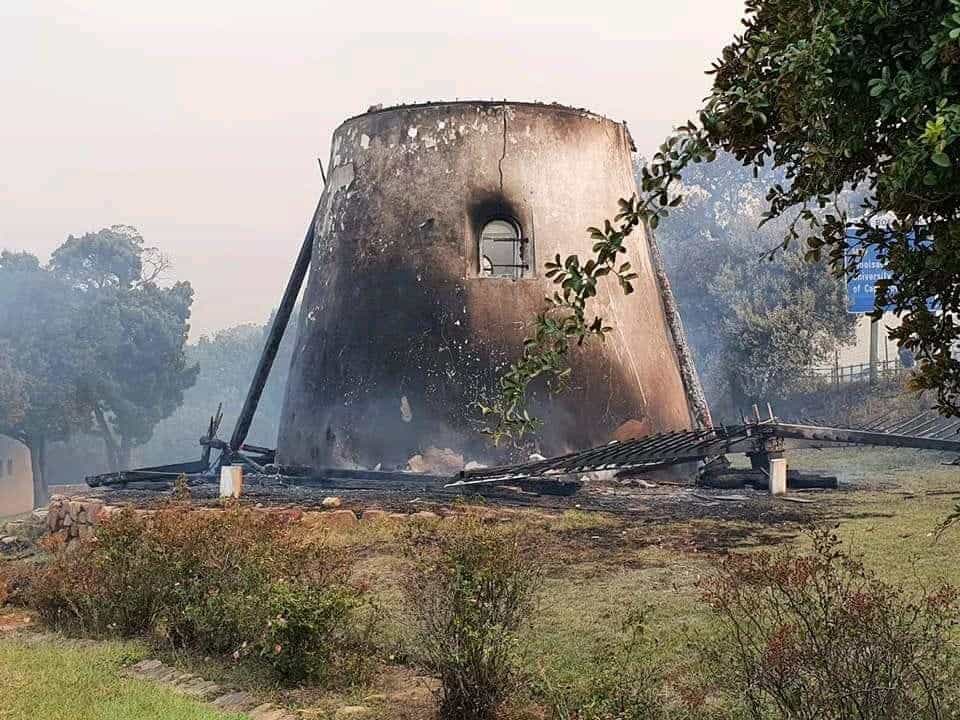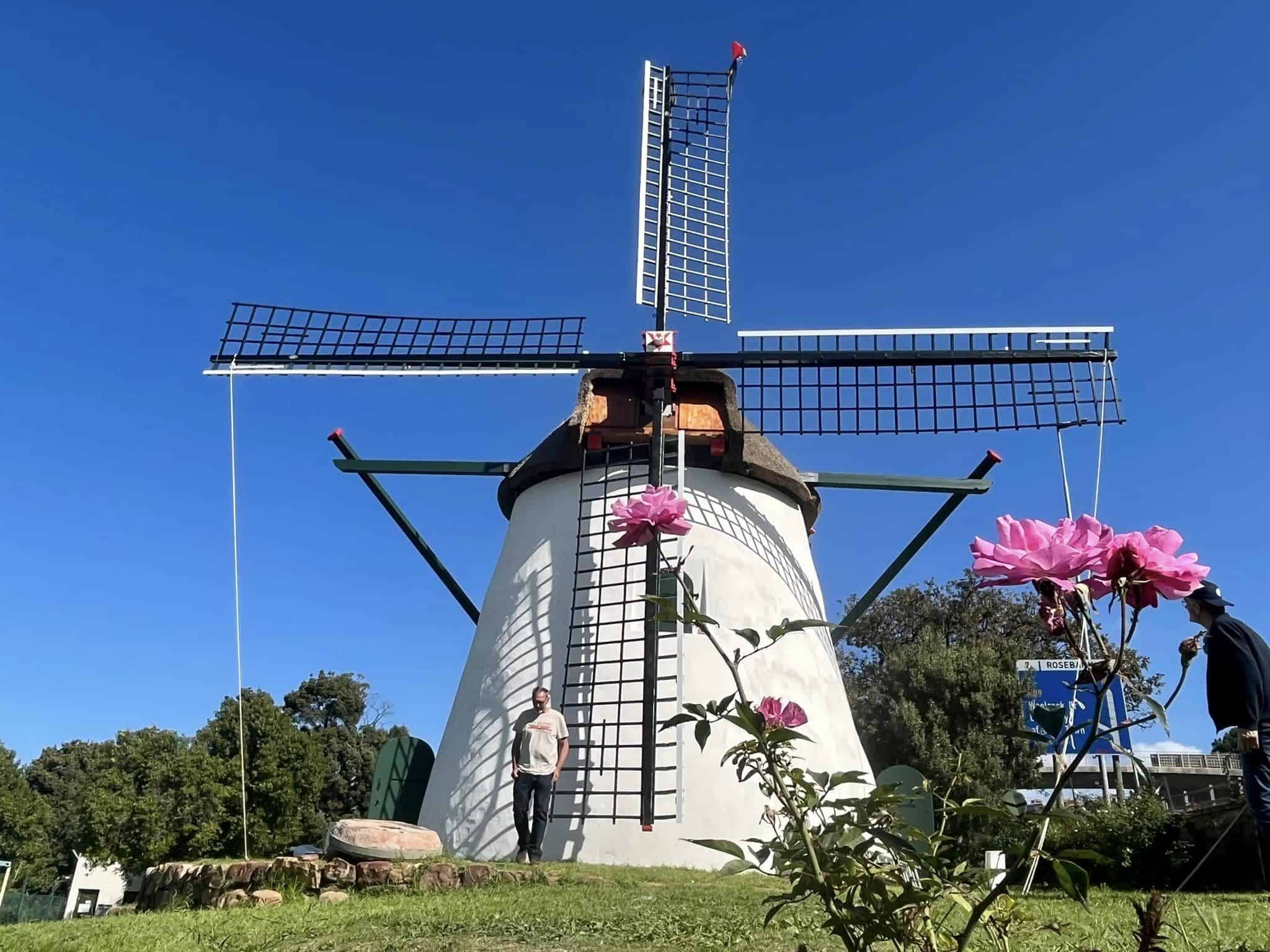Community spirit enables heritage landmark to rise from the ashes
By Alana Bailey
On Sunday, 18 April 2021, a veldfire that started on the slopes of Table Mountain spread across the M3 motorway and caused major damage to several buildings, including the famous heritage landmark, Mostert’s Mill.
This small wind-powered mill was erected in about 1796 on Welgelegen, the farm of Dirk Gysbert van Reenen, to grind grain for the growing Cape population and visitors. Van Reenen’s daughter later married a Mostert, hence the name of the mill.
Mostert’s Mill was once the sole remaining operational windmill south of the Sahara in Africa. Although it is state property, a group of volunteer heritage enthusiasts has been taking care of its maintenance since 1993. At the time, they set up the organisation “Friends of Mostert’s Mill” and have since been taking care of it in close cooperation with the Department of Public Works. Demonstrations often provided the public with the opportunity to see first-hand how the mill worked. However, the sea of flames of 2021 brought an end to the mill’s functionality within minutes.
The story does not end on this tragic note, but instead bears witness to the miracles that community spirit can perform in the field of heritage conservation.
The moment the site could be accessed safely after the fire, members of the Friends were there to secure the remains of the building and mechanisms. A fundraising project was immediately launched nationally and internationally to pay for the comprehensive restoration required. Amongst others, AfriForum contributed to the fund and reported sporadically on the progress made during the past two years.
The restoration work is being coordinated by Andy Selfe, an expert in the field of mills. He recently sent us an email in which he writes:
“As a long-term member of AfriForum, I’d just like to add my personal thanks for the very generous donation your organisation has made to our project! To update you, in two years, with your help we have gone from this …:”

“… to this!”

In the restoration team, Andy is in charge of restoring the working parts of the mill. At first it was believed that foreign expertise would be required to resurrect it from the ashes in a working condition, but Andy proudly states that people with the necessary knowledge have been found in Cape Town and in his hometown, Grabouw. He describes their expertise as unparalleled in the world. All that finally had to be imported, was a second-hand set of millstones and new sails. The rest has all been produced locally. The funds donated by the public, as well as some large donors, helped to ensure that the craftsmen could be properly compensated and the materials that had to be purchased, were paid for. Donations also included building materials, for example stone bearings from JA Clift in Paarl and the roof frame and thatch from JNA Thatchers.
In response to my question why the millstones could not also be produced locally, Andy shared the following interesting information with us. The imported stones are known as French “Burr” stones, which are considered to be the very best kind in the world. These stones can no longer be obtained new, as the quarry from which they had come, had already been exhausted years ago due to the high demand from all over. They were made up from segments which skilled artisans fitted together and bound with steel bands. They then filled the cracks and the reverse side with plaster of Paris. All this was done at La Ferté Sous Jouarre outside Paris.
This particular pair of stones sourced for Mostert’s Mill, had been made at La Ferté Sous Jouarre and had first been used in a water-mill in Barcelona, Spain. They were brought to a collector in the Netherlands, from whom Dutch friends of Mostert’s Mill were able to buy them with the crowd-funding money. It was a bargain, because the collector let the stones go at his cost, which was only the part-load transport cost from Spain. The friends in the Netherlands then reconditioned the millstones before shipping them to South Africa.
Initially it was a challenge to find a pair of “left-hand” stones. This refers to the way they are dressed, for turning anti-clockwise when you are looking at them from the top. Most Dutch windmills turn clockwise, or are “right-handed”. Fortunately this set was left-handed.
Although from the outside it may look as if the restoration has been completed, there remains a lot to be done on the inside. However, Andy and the other Friends are making good progress. Their website is regularly updated with the latest news about the project. A blog also provides information on the reconstruction of parts of the mill, with technical information and photographs that will be of great value to future restorers. Contributions are still extremely welcome and information about this is available at https://mostertsmill.co.za/current-restoration/.
It is encouraging to think that the initiative of a spirited community and the contributions of, among others, AfriForum’s members have helped to revive this precious heritage landmark. Hopefully their actions will inspire other communities to follow suit and actively help to preserve the heritage treasures in their midst.




















